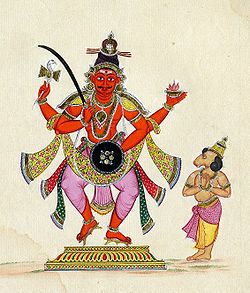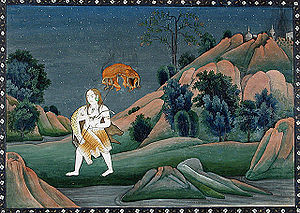- Daksha
-
Daksha 
Ram-faced Daksha (right) with Virabhadra form of ShivaDevanagari दक्ष Consort Prasuti In Hinduism, Daksha, "the skilled one", is an ancient creator god, one of the Prajapatis,[1] the Rishis and the Adityas. Daksha is said to be the son of Aditi and Brahma. (In another source, Daksha is said to be the father of Diti and Aditi, Kashyapa's wives and Sati's sisters).
With his wife Prasuti, he is the father of thirteen daughters, namely Aditi, Diti, Dānu, Kala, Danāyū, Sinhika, Krodha, Pradha, Viswa, Vinata, Kapila, Muni, and Kadru.[2] Many of whom were married to Soma. Daksha found that Soma overly favored one daughter (Rohini) over the others, thus neglecting their needs and flouting his responsibilities. For this, Daksha cursed him to wither and die. The daughters intervened and made his death periodic, symbolized by the waxing and waning of the moon.
Contents
Story of Shakti and Shiva
Daksha is a Sanskrit word said to be a Prajapati or one of the Brahma's sons. The equivalent meaning in English is ALERT. One of the daughter of Prajapati (often said to be the youngest) was Shakti or Dakshayani, who had always wished to marry Shiva. Daksha forbade it, but she disobeyed him and did so anyway, finding in Shiva a doting and loving husband. Daksha disliked Shiva intensely, calling him a dirty, roaming ascetic and reviling the great yogi's cohort of goblins and ghouls.
The Yagna of Daksha
From then on, he distanced himself from his daughter, Dakshayani/Shakti, and his son-in-law, Shiva. This enmity culminated in a great sacrifice he had been hosting, one to which he invited all and sundry, family and allies, gods and rishis, courtiers and subjects. Consciously excluding Shakti from the list, he also set up a statue of Shiva, which he defiled and mocked, at the entrance to his hall. Shakti, ebullient at the thought of such a great event, and assuming that the daughter of the king was welcome no matter what, attended the festival. Snubbed by her father and treated with disdain, Shakti nonetheless maintained her composure. Indeed, even her father's refusal to invite Shiva, her husband and thus a traditionally honored member of any Hindu family, was to some extent borne.
However, on seeing the shameless insult to her husband in his absence, and the repeated slights King Daksha and his courtiers railed at Shiva, she committed suicide in grief for her beloved. Hearing the news, Shiva's attendants rushed inside the ceremony hall and started attacking all the guests present there, however, the demons invoked by Bhrigu defeated Shivas attendants and they retreated back to his abode. Upon hearing the news of his beloved wife's death, Shiva was furious that Daksha could so callously cause the harm of his (Daksha's) own daughter in so ignoble a manner. Shiva grabbed a lock of his matted hair and dashed it to the ground. From the two pieces rose the ferocious Virabhadra and the terrible Rudrakali, while Bhadrakali arose from the wrath of Devi herself.[3] Upon Shiva's orders they stormed the ceremony and killed Daksha as well as many of the guests. Terrified and with remorse the others propitiated Lord Shiva and begged his mercy to restore Daksha's life and to allow the sacrifice to be completed. Shiva, the all-merciful One, restored Daksha's life, with the head of a goat. In his humility, and repentance for his graceless and sinful acts, Daksha became one of Shiva's most devoted, attendants.
Shakti/Dakshayani later incarnated as Parvati in her next life, and remarried Shiva, henceforth never to part with him again. It is for this reason that Shiva, while monogamous, has had two wives in reality, but the same soul in two incarnations.
One place that is associated with this Yagna of Daksha, and where it is supposed to have actually taken place according to the Sthala Purana, is known as Kottiyur, which is in a largely forested area of Kannur District, Kerala.[4] At Kottiyur, there are two temples - Sri Akkare Kottiyur Temple and Sri Ikkare Kottiyur Temple, located on opposite banks of Bavali river. Sri Akkare Kottiyur Temple is open during the Kottiyoor Vaisakha Mahothsavam festival only.
Another place that claims to be the site of Daksha's Yagna is Shri Daksheshwar Temple, about 4 KM from Haridwar. There is a pit within the grounds of the temple which supposedly marks the exact location of the sacrificial fire.
Local legend has it that Draksharama was where the Daksha yagna was performed. It is one of the Pancharama sites and is located near Kakinada in East godavari district, AP.
Other daughters
Some of Daksha's other daughters include Bharani and Anuradha, married Chandra. Another, Rati, married Kama. Another daughter, Danu, gave birth to the evil Danavas. According to the Monnier-Williams dictionary Samkalpa (initiative/volition) is mentioned as a daughter of Daksha. There is a theory identifying Samkalpa with Lubhyati, the Sanskrit name-word etymologically related to love and libido.
See also
- Dakshayagnam (film)
- Kumhar
- Prajapati
- Dakshayani
- Dakshina
- Draksharama
- Kankhal
- Kottiyur
References
- ^ Narada said.. The Mahabharata translated by Kisari Mohan Ganguli (1883 -1896), Book 2: Sabha Parva: Lokapala Sabhakhayana Parva, section:XI. p. 25 And Daksha, Prachetas, Pulaha, Marichi, the master Kasyapa, Bhrigu, Atri, and Vasistha and Gautama, and also Angiras, and Pulastya, Kraut, Prahlada, and Kardama, these Prajapatis, and Angirasa of the Atharvan Veda, the Valikhilyas, the Marichipas; Intelligence, Space, Knowledge, Air, Heat, Water, Earth, Sound, Touch, Form, Taste, Scent; Nature, and the Modes (of Nature), and the elemental and prime causes of the world,--all stay in that mansion beside the lord Brahma. And Agastya of great energy, and Markandeya, of great ascetic power, and Jamadagni and Bharadwaja, and Samvarta, and Chyavana, and exalted Durvasa, and the virtuous Rishyasringa, the illustrious 'Sanatkumara' of great ascetic merit and the preceptor in all matters affecting Yoga..."
- ^ Lineage of Daksha The Mahabharata, Book 1: Adi Parva/Section LXV, translated by Kisari Mohan Ganguli (1883 -1896).
- ^ the Horse-sacrifice of the Prajapati Daksha The Mahabharata translated by Kisari Mohan Ganguli (1883 -1896), Book 12: Santi Parva: Mokshadharma Parva: Section CCLXXXIV. p. 317. “I am known by the name of Virabhadra’’ and I have sprung from the wrath of Rudra. This lady (who is my companion), and who is called Bhadrakali, hath sprung from the wrath of the goddess.”
- ^ http://www.hindu.com/2006/06/17/stories/2006061708850500.htm
- Dictionary of Hindu Lore and Legend (ISBN 0-500-51088-1) by Anna Dhallapiccola
External links
- Lineage of Daksha, The Mahabharata/Book 1: Adi Parva/Section LXV
- Legend of the Draksharama temple [1]
Hindu deities and texts Gods 
Goddesses Texts Hinduism · Hindu mythology · Indian epic poetry Categories:- Creator gods
- Prajapatis
- Adityas
- Nature gods in Hinduism
- Sanskrit words and phrases
Wikimedia Foundation. 2010.

